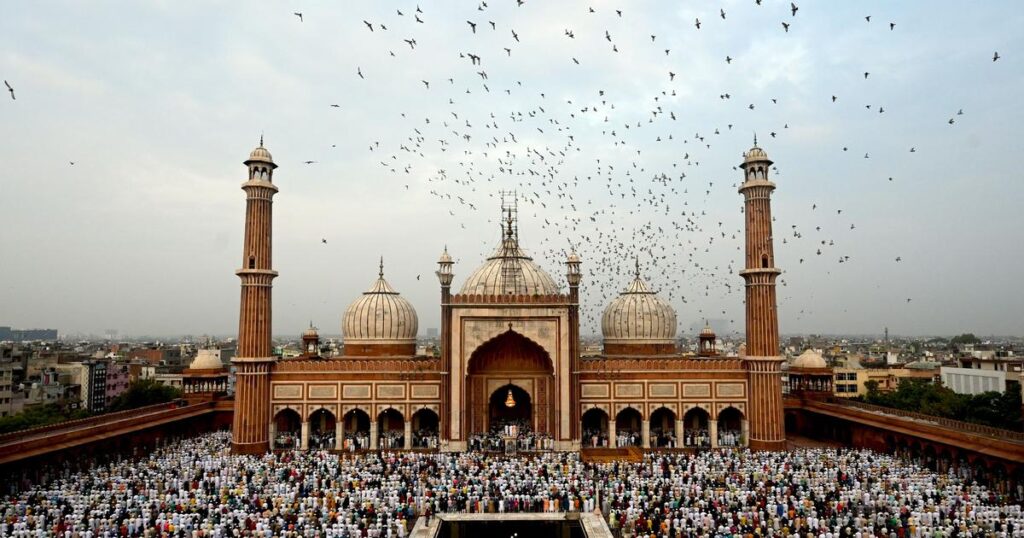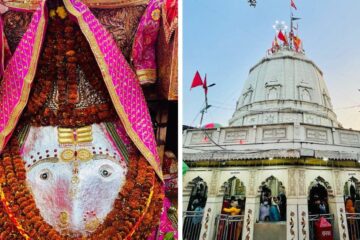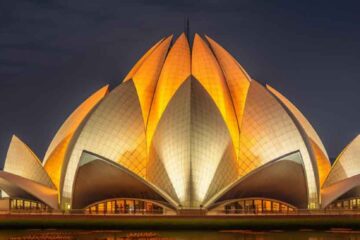Jama Masjid Delhi

For good reason, Delhi’s Jama Masjid is often considered the grandest mosque in India. Located in the heart of Old Delhi, this massive 17th-century structure is a symbol of the architectural grandeur of the Mughal emperor Shah Jahan. Due to its immense popularity, the mosque is a must visit when visiting the country’s capital.
Do you want to know more about Delhi’s most important historical site? Everything you need to know about Delhi Jama Masjid is covered in this blog, including its history, architecture, opening timings, entry prices and other fascinating facts.
Delhi Jama Masjid Quick Info
| Location | Off Netaji Subhash Marg, Chandni Chowk |
| Type | Mosque |
| Also Known as | Masjid-i Jahan-Numa |
| Masjid Timings | 7:00 am to 12:00 pm and 1:30 pm to 6:30 pm; every day (tourists not allowed during the prayer hours) |
| Minaret Timings | 9:00 am to 5:30 pm |
| Masjid Entry Fee | Free |
| Minaret Entry Fee | ₹ 100 |
| Camera Charges | ₹ 300 |
| Nearest Metro Station | Jama Masjid Metro Station |
| Commissioned by | Shah Jahan |
| Year of Establishment | 1656 |
| Cost of Construction | 1 million rupees |
| Architectural Style | Indo-Islamic and Mughal |
| Material Used | Red sandstone and white marble |
| Status | A mosque and a tourist place maintained by Delhi Waqf Board |
Delhi Jama Masjid: History
Jama Masjid was built by Shah Jahan in the walled city of Shahjahanabad, also known today as Old Delhi. Shahjahanabad served as the capital of the Mughal Empire throughout its reign. The construction of the mosque took twelve long years to complete, starting in 1644 and ending in 1656. The construction project involved about 5000 laborers under the guidance of the Emperor’s Prime Minister, Saadullah Khan. Shahjahan spent ten lakh rupees on the construction of this grand monument and left no stone unturned.
Masjid-e-Jahan Numa, which translates to “Mosque that reflects the world,” was the original name of the mosque. Then it was called Friday Masjid or Jama Masjid. At the invitation of Shah Jahan, an Imam named Abdul Ghafur Shah Bukhari traveled from Bukhara (present-day Uzbekistan) to inaugurate the mosque on July 23, 1656. Additionally, Shah Jahan named him the first Shahi Imam of the mosque.
The Red Fort, another famous structure of Shah Jahan, is located next to the mosque, which has stood tall in the city since its inception. It served as the royal mosque of the emperors until the end of the Mughal period. The mosque was taken over by the victorious British rulers with the aim of demolishing it after the Revolt of 1857. Nevertheless, vocal opposition from the public forced them to reevaluate this option, saving the structure from further damage. Delhi Waqf Board is currently in charge of the mosque.
Delhi Jama Masjid Architecture
The best mosque built during the Mughal Empire is considered to be the Jama Masjid of Delhi. Its length is approximately 261 feet, and its width is 90 feet. It was constructed in the Indo-Islamic architectural style using red sandstone and white marble. Three massive arched gates, three marble domes, four minarets, and two grand minarets adorn the building. Additionally, it has a large courtyard that can accommodate 25,000 people at a time for prayers.
There are 35 steps leading up to the eastern entrance, one of the three entrances to the mosque. Since it was available only to the Mughal emperors, this gate is sometimes called the Imperial Gateway. There are 39 steps leading to the northern gate and 33 steps leading to the southern gate. At a height of 130 feet, each of the two minarets is made up of five floors and has a long balcony. There are 130 steps leading to the top of each tower.
The floor of the mosque is a remarkable black and white marble design, with 899 areas marked for attendees. The interior of this mosque is decorated with fluorescent motifs, floral patterns, and grand arches. The arch leading to the center of the prayer hall bears the words “The Guide.”. Important artefacts housed in the mosque include a copy of the Quran written on deer skin, a strand of red hair from the Prophet Mohammed’s beard, a pair of his shoes, and his footprints on a block of marble.
Delhi Jama Masjid: Today
This centuries-old mosque is now one of the most popular tourist destinations in Delhi. Being one of the largest mosques in the country, it attracts visitors and worshipers from all over India and abroad. During the month of Eid, the mosque is packed with worshipers coming to offer namaz, or prayers. The mosque has two minarets, although only the one at the southern end is available to the public at a low cost. The mosque looks spectacular when illuminated in the evening.
To enter the mosque, you must dress appropriately. Additionally, if you are not prepared, clothing is available for rental at the North Gate.
Lesser-known facts about Jama Masjid, Delhi
- One of the last architectural wonders of Shah Jahan is the mosque.
- Shah Jahan used the eastern gate to enter the mosque during his reign. The southern gate was for popular access, while the northern gate was for the use of the elite.
- While designing the structural layout of the Badshahi Mosque in Lahore, Shah Jahan’s son, Aurangzeb, took inspiration from this mosque.
- On its grounds, the mosque housed a madrasa before the Revolution of 1857. It was destroyed in the rebellion.
- A donation of Rs 75,000 was requested from the last Nizam of Hyderabad in 1948 to restore one-fourth floor of the building. Instead of giving money, the Nizam contributed three lakh rupees, with the condition that the floor of the entire mosque be repaired so that no part remains old.
- The largest mosque in India is not the Delhi Jama Masjid, as many people think. Topping the list is the 175,000-seat Taj-ul-Masjid in Bhopal.
- Connaught Place and Parliament House are right opposite the mosque.
Attractions near Jama Masjid, Delhi
- Chandni Chowk Market (220 m)
- Shri Digamber Jain Lal Mandir (750 m)
- Red Fort (1 km)
- Fatehpuri Masjid (1.7 km)
- Gurdwara Sis Ganj Sahib (2.1 km)
- Gauri Shankar Mandir (2.4 m)
- Stephen’s Church (2.6 km)
- Raj Ghat (2.7 km)
- Khari Baoli Spice Market (2.8 km)
- India Gate (6.1 km)
- Humayun’s tomb (9.9 km)
Things to Do near Delhi Jama Masjid
In Delhi, if you are a foodie or a shopaholic, there are lots of interesting things to do near Jama Masjid. For example, don’t leave the area without sampling some of the famous restaurants next to the mosque and their amazing kebabs. You can also do some shopping.
- Aslam Chicken Corner for butter tikka chicken
- Qureshi for kebabs
- Cool Point for desserts
- Kinari Bazaar for wedding shopping
- Dariba Kalan Market for jewelry
- Nai Sarak for books
- Khari Baoli for spices
Undoubtedly, Jama Masjid is one of the top historical sites in Delhi if you want to see the grandeur of the Mughals. Now that you have all the information you need to visit the Delhi Jama Masjid, why not plan to spend 30 minutes there in addition to eating and shopping?



3 Comments
Red Fort, Delhi: Information, Features, Architecture, and Facts · February 20, 2024 at 4:11 pm
[…] Jama Masjid (900 m) […]
Raj Ghat, Delhi: Information, History, Timings, Entry Fee · February 20, 2024 at 4:12 pm
[…] JAMA/ MASJID (2.5 km) […]
India Gate Delhi: History, Architecture, Timings, Entry Fee · March 9, 2024 at 8:43 am
[…] Jama Masjid (5.8 km) […]